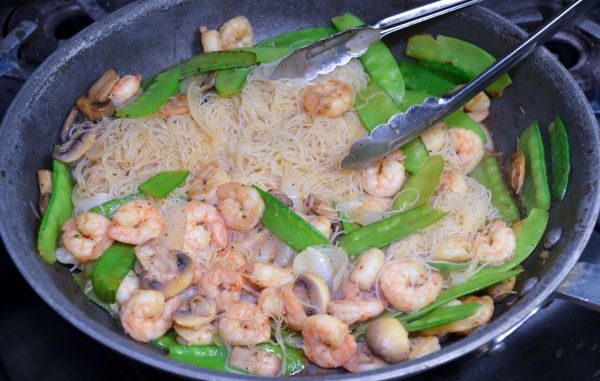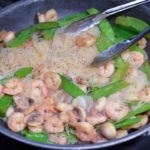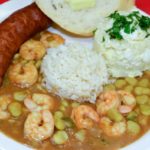
A lot of you have probably heard of Uncle Larry. If you haven’t, you should, and since he has retired from his day job you more than likely will.
He is starting his own food company.
The two of us consider Larry Roussel a good friend. Our paths have crossed a lot over the years. Recently, after accepting an invitation to cook with him at Poche Plantation in Convent, Roussel recalled our first meeting.
“In 2002, I vividly remember stopping at your booth at the Louisiana Sportsman Show (when author Jerald Horst was an LSU fisheries biologist),” Roussel said. “I said that I wanted you to put the recipe for the Patriot (a dish with red snapper, white shrimp, and blue crab) in the newsletter you wrote.
“You said, ‘I don’t put anything in the newsletter unless it is tried and true.’ I sent the recipe to you, and you must have tried it and liked it because you published it.
“I sent two more recipes, Kickin’ Corn Soup and Brown Gravy Oyster Spaghetti. You published them both. I’m proud to say that all three were published in the Louisiana Seafood Bible cookbooks you and Glenda wrote.”
Since then, Larry has become something of a TV cooking celebrity, appearing either regularly or multiple times on WBRZ 2 in Baton Rouge, KLFW 10 in Lafayette, WWL 4 and ABC 26 in New Orleans, and Eatel Television in Gonzales.
He is known as “Uncle Larry” everywhere he appears, except at WBRZ TV, where they insist on calling him “Couzin Larry.”
His last name Roussel, alternatively spelled as Roussell or Rousselle by others bearing the name, is a very common River Parishes Cajun name.
Larry is sensitive to the fact that River Parish Cajuns are often not recognized as being Cajun.
“I’m 100 percent Acadian,” he said. “Although some of our ancestors came directly from France, most were exiled from Nova Scotia.
“The first Acadian Coast was the River Parishes. Ascension and St. James parishes were one parish named Acadia Parish between 1804 and 1807. The River Parishes now include Ascension, St. James, St. John, and St. Charles parishes.
“One of the goals of my life is to prove that we are as Cajun as the rest of Acadiana. The River Parishes are overlooked because people focus on the Lafayette area.”
While River Parishes folk are Cajun, Larry is quick to note that their cooking is distinctive. One difference was in their use of river shrimp.
“Every family had wooden shrimp boxes that they baited with fruit scraps,” he explained. “Some would sell them in Hester and Paulina for 25 cents a bucket. They are smaller and sweeter than saltwater shrimp.
“Shrimp and corn soup, a dish that Hymel’s Restaurant (founded 70 years ago) in Convent is famous for, was originally made with river shrimp.
“Our dishes are different, as well. Red bean gumbo is an example. Everybody in St. James Parish who cooks gumbos makes a red bean gumbo. It was made during Lent, and was made with raw eggs dropped in it.
Chicken-and-andouille gumbo also was very popular in the area, he said.
“We grew up using andouille for seasoning,” Roussell said. “Authentic andouille is a sausage with a very chunky texture and is heavily smoked. Veron’s was very famous for their andouille in St. James Parish.”
He explained that River Parishes people also use a lot of pickled meat for seasoning. Pickled meat is popular in New Orleans, but not the rest of Acadiana.
“Tasso was one seasoning meat I never heard of growing up,” the 61-year old said. “Snap bean stew is a common River Parishes dish. We like ours made with pickled meat. You make a roux, add pickled meat to make a gravy. Then you add new potatoes, and then you add the beans. Simmer it uncovered until it’s done and serve it with rice.
“Cabbage stew is pretty common in St. James, although I can’t speak for St. John and especially St. Charles. Cube a Boston butt and cook it down in oil. Season it with bell peppers and onions, and add the cabbage. Serve it over rice.”
A lot of River Parishes Cajun cooking involves vegetables. Larry said truck farming in the rich soils on the banks of the Mississippi River was a big business. He recalled that the main commercial product was bell peppers. Every family also had its own garden plot, as well.
A final dish that Roussel couldn’t skip was jambalaya.
“We made it with the ends of cold-cut loaves, sliced wienies and sliced sausage,” he said. “Every small community grocery store would sell this ‘jambalaya mix.’”
Uncle Larry’s Food and Spice Company is developing a Cajun Seasoning Blend and Flavor Enhancer, Stew-in-a-Few (liquid Cajun stew — just add meat or seafood), Ready-Set-Gumbo with or without okra (also a liquid — just add seafood or meat) and Uncle Larry’s Dry Rub for barbecuing.
If you can’t find them in a store near you, call Roussel at 225-417-8110.
Cajun Stir-Fried Shrimp with Rice Noodles
“This is my invention,” said Larry. “Although I don’t consider myself an Asian expert, I like Asian dishes. I like the idea of cooking each ingredient one at a time. I stir fry often.”
He grinned about using rice noodles.
“I’m a Cajun,” he said. “Rice noodles are still rice.”
This is a very quick and simple dish. Like most stir-fry dishes, more time goes into preparing the ingredients than into cooking.
The dish is unique for a couple of reasons. One is the use of wine to deglaze the pan. The other is the liberal amount of cooking oil that Larry starts with.
Don’t cut back on the oil, though. It is needed to sauce the noodles at the end.
INGREDIENTS:
- 6 oz. rice noodles or rice sticks
- 1/4 cup olive oil
- 1 lb. peeled medium shrimp tails
- 1 tbsp. Cajun/Creole seasoning
- 1 medium onion cut in strips
- 16 oz. sliced mushrooms
- 2 cups fresh snow peas (strings removed)
- sriracha cup white wine
PREPARATION:
Place the rice noodles in a bowl of ice water and soak for 15-20 minutes until soft. Break the noodles apart with a fork as they soften. Drain the noodles and set them aside. Heat the oil in a large skillet on high heat. Add the shrimp and Cajun seasoning, and cook until the shrimp turn pink. Add the onions and mushrooms, and cook for about 3 minutes until the vegetables are tender. Add the snow peas and rice noodles. Roll the noodles around the pan to pick up the liquid and heat for about 3 minutes. Add the white wine partway through the noodle stirring process. Serve with sriracha hot chili sauce or wasabi sauce for added spice. Serves 6.
Uncle Larry’s Lima Beans & Shrimp
Larry calls this a “heritage dish.” It was originally made with river shrimp. They ran best in the spring at the same time that lima beans, called “butter beans” back then, came in.
His family ate the dish once a week during the season.
INGREDIENTS:
- 1/2 cup cooking oil
- 1 medium onion, diced
- 1 stalk celery, diced
- 1/2 cup Good Medal Wondra flour
- 1 tbsp. chicken bouillon granules
- 1 1/2 tsp. Cajun/Creole seasoning
- 1 heaping tsp. dried parsley flakes
- 1 quart water
- 1 1/2 tsp. Kitchen Bouquet
- 1 1/2 lbs. frozen lima beans
- 1 lb. medium shrimp, peeled
- 1/2 cup bell pepper, diced
PREPARATION:
Heat the oil in a large pan over medium heat. Add onion and celery and sauté for 5 minutes or until soft. Add flour and cook for 2 minutes, stirring frequently. Add bouillon, Cajun seasoning, parsley flakes, water and Kitchen Bouquet. Bring to a boil. Add lima beans and return to a boil, and then reduce heat to low and simmer until the lima beans are tender. Turn the heat to high, add shrimp and bell pepper. When it returns to a boil, reduce the heat to a simmer for 15 minutes. Serves 4-6.





